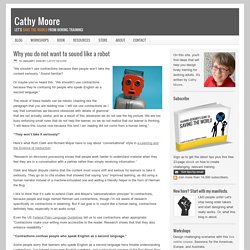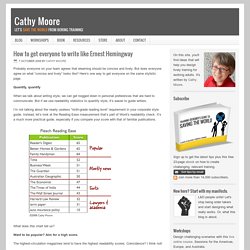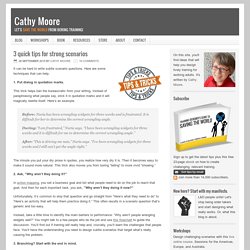

Informal writing style works better for elearning. “We shouldn’t use contractions because then people won’t take the content seriously.”

Sound familiar? Or maybe you’ve heard this: “We shouldn’t use contractions because they’re confusing for people who speak English as a second language.” The result of these beliefs can be robotic chanting like the paragraph that you are reading now. I will not use contractions as I say that sometimes we become obsessed with details of grammar that are not actually useful, and as a result of this obsession we do not see the big picture. We are too busy enforcing small rules that do not help the learner, so we do not realize that our learner is thinking, “I will leave this course now because this text I am reading did not come from a human being.” “They won’t take it seriously!” Here’s what Ruth Clark and Richard Mayer have to say about “conversational” style in e-Learning and the Science of Instruction: “Contractions confuse people who speak English as a second language.” The trick is to know your learners. Using readability standards in elearning.
Probably everyone on your team agrees that elearning should be concise and lively.

But does everyone agree on what “concise and lively” looks like? Here’s one way to get everyone on the same stylistic page. Quantify, quantify When we talk about writing style, we can get bogged down in personal preferences that are hard to communicate. But if we use readability statistics to quantify style, it’s easier to guide writers. I’m not talking about the nearly useless “ninth-grade reading level” requirement in your corporate style guide. What does this chart tell us? Want to be popular? The highest-circulation magazines tend to have the highest readability scores. Instructions can be short and lively I included Better Homes and Gardens and Family Handyman because they cover a lot of the same territory that elearning does: they motivate you to make a change and tell you how to do it. What score should you aim for? De-drone to improve your score and motivate learners.
Hemingway app helps you write concisely. Plain English Campaign free guides. Randomly Generate Fake Names at uinames.com. 10 Easy Ways to Improve Your Dialogue. “And what is the use of a book,” thought Alice, “without pictures or conversations?”

– Lewis Carroll I can manage books without pictures, but I know how Alice feels about the conversations. When I’m browsing, I flick through books to see how much dialogue there is. If there doesn’t seem to be much, I’ll put the book down and choose something else. I’m pretty sure I’m not the only person who does this, either… As a writer, dialogue lets you: Show rather than tell – when characters act and speak, they become real to usBuild tension and drama, furthering the plotReveal character in what’s said (or what isn’t said)Create white space on the page – attractive to busy readers But many writers list “dialogue” as one of the key things they struggle with.
So what makes for good dialogue? #1: Watch Your Dialogue Tags A “dialogue tag” is the bit you put before or after the dialogue, like: he saidshe askedI replied Normally, the word “said” will do just fine. . #2: Ground Your Dialogue in a Scene. Book on writing dialogue. 3 quick tips for strong scenarios. It can be hard to write subtle scenario questions.

Here are some techniques that can help. 1. Put dialog in quotation marks. This trick helps ban the bureaucratic from your writing. Instead of paraphrasing what people say, stick it in quotation marks and it will magically rewrite itself. Before: Nuria has been wrangling widgets for three weeks and is frustrated. The minute you put your dry prose in quotes, you realize how very dry it is. 2. In action mapping, you set a business goal and list what people need to do on the job to reach that goal. Unfortunately, it’s common to skip that question and go straight from “Here’s what they need to do” to “Here’s an activity that will help them practice doing it.” Instead, take a little time to identify the main barriers to performance: “Why aren’t people wrangling widgets well?” 3. Before you write any part of a branching scenario, think of the endings that will make the points you want to make.
Scenario design course: New sessions available.